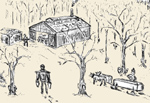
Winter 2004

 |
|
 |
| Home | Index | Museums | Blog | Authors | Site Map | About |
|
Maple Sugar MakingFrom the Ohio Farmer, February 1870contributed byRichard PalmerThe great secret of sugar making is in being prepared when the season opens; so contriving the operations of manufacture as to make them the least laborious; to care for the preservation of the forest, and save all the sap that is taken from the trees. There is probably no greater source of loss in sugar making than the waste of sap, and the waste usually comes from leaky store troughs, neglect, carelessness in gathering, and small buckets. How often does the farmer find, when going to the woods, "Everything running over!" How long they have been doing so is not known, and therefore no correct estimate of loss can be made. But we can determine with some accuracy the loss attending the use of small vessels. We will suppose that in one half of the camp tin pans, jars or troughs are used which will hold but six quarts each, and in the remaining half, buckets which will hold 16 quarts each. Now, when the gathering has been neglected until the larger buckets are full, which will ordinarily occur several times in a season, here has been a waste of 10 quarts at each of the trees having the small vessels, and, supposing that number to be 200, there has been a loss of 2,000 quarts, or 500 gallons of sap, which, at a safe calculation, would have made 125 pounds of sugar. A number of years ago we knew a man who was particularly noted for the amount of maple sugar he made every season per tree, so much that it was asserted that he could get more sugar out of creek water than the others could out of sap. When this man was asked for the secret of his success, he replied, "I save all the sap." Index to articles by Richard F. PalmerCLR Blog | Site Map | Contact CLR |